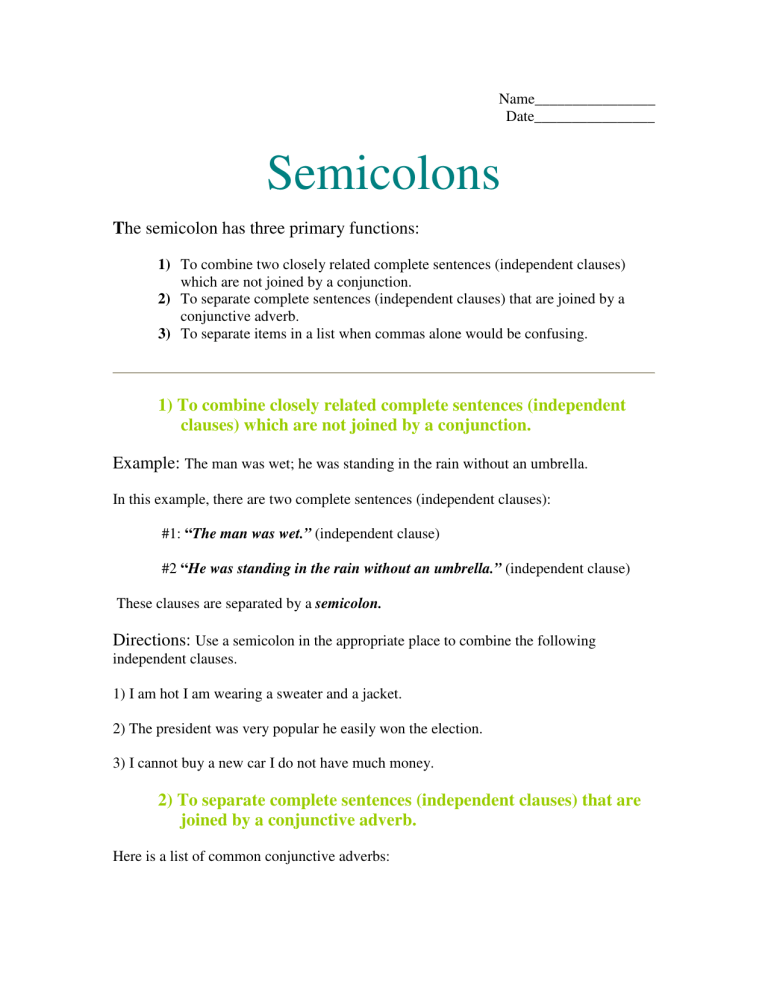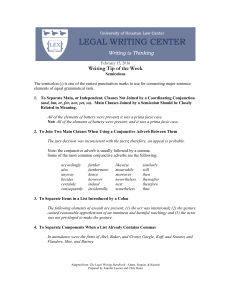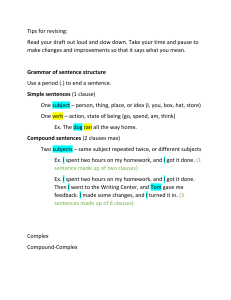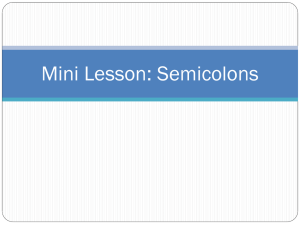
Name________________ Date________________ Semicolons The semicolon has three primary functions: 1) To combine two closely related complete sentences (independent clauses) which are not joined by a conjunction. 2) To separate complete sentences (independent clauses) that are joined by a conjunctive adverb. 3) To separate items in a list when commas alone would be confusing. 1) To combine closely related complete sentences (independent clauses) which are not joined by a conjunction. Example: The man was wet; he was standing in the rain without an umbrella. In this example, there are two complete sentences (independent clauses): #1: “The man was wet.” (independent clause) #2 “He was standing in the rain without an umbrella.” (independent clause) These clauses are separated by a semicolon. Directions: Use a semicolon in the appropriate place to combine the following independent clauses. 1) I am hot I am wearing a sweater and a jacket. 2) The president was very popular he easily won the election. 3) I cannot buy a new car I do not have much money. 2) To separate complete sentences (independent clauses) that are joined by a conjunctive adverb. Here is a list of common conjunctive adverbs: Example: Jane likes fruit; however, she does not like apples. In this example, there are two complete sentences (independent clauses): #1: “Jane likes fruit.” (independent clause) #2 “She does not like apples.” (independent clause) These clauses are separated by a semicolon and the conjunctive adverb “however”. Directions: Use a semicolon and a conjunctive adverb to combine the following independent clauses. 1) I am wearing a sweater and a jacket ____________ I am cold. 2) The old dog is blind ____________ it is deaf. 3) Mix all the ingredients ____________ put the batter in the oven. 3) To separate items in a list when commas alone would be confusing. Example: The school specializes in three fields of study: economics, the study of the economy; philosophy, the study of thought; and anthropology, the study of mankind. Directions: Use a semicolon in the appropriate place to separate items in a list in the following sentences. Name________________ Date________________ The Colon The Colon can be used in the following 7 ways: 1) Before a list that is introduced by a complete sentence. Example: The reporter interviewed the following people: the department heads, the members of the faculty council, and a representative group of students. 2) To introduce the effect, or logical consequence of an action. Example: There was only one way he could win: he had to cheat. 3) Before a quotation. Example: This is what Plato had to say about mathematicians: “I have hardly ever known a mathematician who was capable of reasoning.” 4) After the salutation in a business letter or memo. Example: Dear Senator Harkin: 5) To separate chapter and verse in scripture. Example: The Sunday school class studied James 4:10 6) To separates hours from minutes. Example: Our soccer game starts at 7:30. 7) To show ratios. Example: Pour in the milk and water at a 3:1 ratio. Directions: Fill in the missing colons. 1) I gave you the spray bottles for one reason to clean the windows. 2) You will need the following ingredients milk, sugar, flour, and eggs. 3) Johann set the alarm clock for 6 00. 4) My father ended every conversation the same way “Don’t give up.” 5) Dear Mr. Kurasu of the Kiragowa Corporation 6) Mix the oil and vinegar at a 1 2 ratio. 7) I have invited the following people to my party Kevin, Amy, and Keeley. 8) There is only one way to make it to the top hard work. 9) The soldier shouted the following before leaving to war “We shall return victorious!”



